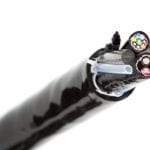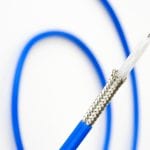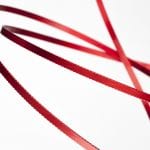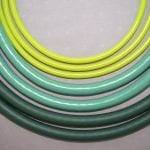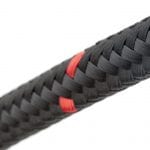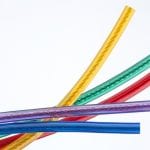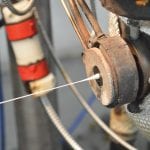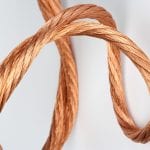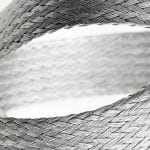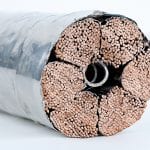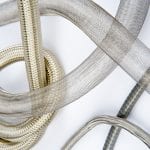Why are shields used in electrical cable?
In addition to the benefit of protection against damage to cable components from cable motion and use, proper shielding is essential to many applications as it can keep out unwanted external interference. In many applications, electromagnetic interference (EMI) is a threat to signal integrity. Shield quality is of particular importance in small signal or high frequency applications where a slight variation can have significant impact. All electrical cable will radiate energy to, and pick up energy from, its surroundings. As such, shielding can also be used to contain the electromagnetic energy radiated by a cable, which can protect nearby sensitive components.
The types of shields used by New England Wire
The three most common shield types used by New England Wire for multi-conductor cable are braid, spiral, and foil. A braided shield is made of interwoven conductive wire. A braid can be manufactured using a wide variety of materials and wire sizes and can be applied over an extensive range of cable diameters. A spiral shield is made of conductive wire helically wrapped over the core. As with a braid, a variety of materials and wire sizes can be used, however, spiral shields are generally limited to small or mid-sized cables in order to achieve high coverage. A foil shield is a metallic foil helically wrapped around the cable with overlap. A variety of foil options can be utilized, however, most common is aluminum laminated with a polyester backing. Variations or combinations of the standard types are often used to provide a custom solution to a particular application.
In addition to wire and foil based shielding options, we can also manufacture with semi-conductive tapes, coatings or extruded layers. These are typically used in conjunction with wire based shields to provide additional shielding, but more notably, they are used for low noise or corona resistant high voltage cables.
So which shield type is best?
The ideal shielding method for any application depends on the specific application for which it is going to be used. For example, shielding effectiveness at low frequencies is largely influenced by resistance. Therefore, wire based shields such as spirals and braids are ideal. At high frequencies, coverage becomes the primary factor making 100% coverage foil shields the most effective option. At mid-range frequencies both resistance and coverage are influential so a high coverage braid is typically used.
While shielding effectiveness is often one of the primary concerns for most applications, other impacts of shielding should be considered. Design constraints such as flexibility, flex life, diameter, weight, and cost may influence the shield selection. Furthermore, in order to get the full benefit of shielding, the shield must be grounded properly, consequently, means of termination can play a role in shield selection.
Variations or combinations of the standard shield types are often used to maximize shielding effectiveness for a given application. For example, stacking a foil and braid will provide a shield with 100% coverage and low resistance making it effective from low to high frequencies.
| Standard Shield Options | Braid | Spiral | Foil |
|---|---|---|---|
| Description | • Metallic wire interwoven to from a tubular structure • May also be formed to a rectangular cross section | •Metallic wire helically wrapped around a core | •Metallic foil typically laminated to a thermoplastic layer wrapped around a core with overlap |
| Core Size | .012" and larger | .004" - .450" | .025" and Larger |
| Single End AWG Range | 30-46 AWG | 36-52 AWG | N/A |
| Flexibility | Good | Very Good | Poor |
| Flex Life - Continuous Flexing | Good | Poor | Poor |
| Typical Coverage | 90% | 90-95% | 100% |
| Typical Frequency Range | Low to mid frequencies (Up to 100 MHz) | Low frequencies (Up to about 1 MHz) | High frequencies (Greater than 100MHz) |
| Ease of Termination | • Braided wire can be separated and terminated •Can be challenging so a drain wire is sometimes used | •Not interwoven so easy to terminate using individual shield wires or multiple strands twisted together | •Difficult •A drain wire is often beneficial |
| Advantages | •Provides structual integrity while still maintaining good flexibility and flex life with contnuious flexing •Lowest resistance •Provides other mechanical benefits (cut through/crush resistance) | •Most flexible option •Less build than braid •Can be easily manufactured with 95% coverage •Less weight | •Provides 100% coverage allowing effectiveness at high frequencies •If aluminum foil used, this option offers low weight and cost |
| Concerns | •Largest increase in OD •Brain pattern limits maximum coverage to 95%, gaps in braid limit effectiveness at high frequencies | •If bent or flexed in use the spiral can open up limiting effectiveness to lower frequencies •Inductive effect as a result of shield wires helically wrapped around core | •High resistance limits effectiveness at low frequencies •Not recommended for continuous flexing applications •Termination options are limited |







